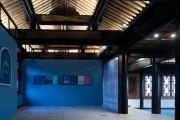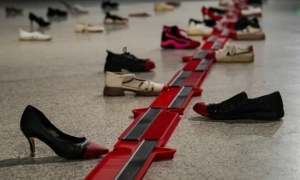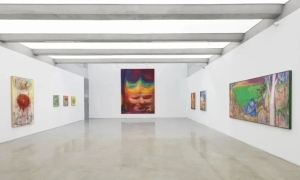少 年 游
徐 累
传统艺术衡量于当代实践是一种“立竿见影”的关系。既然我们都清楚过去的经典早就树起了伟大的标识,就没有理由对这种曆史的照应视而不见,或者因爲影响的焦虑而掉头不顾。全球化的路线企图使世界文化的多义性和丰富性隐入夜晚,这并不是一个善意的结论。中国当代艺术的远行已经发生,但我们应该提醒自己,离开是爲了更清楚地回望,我们在这个地界努力延伸,是爲了更有一种合理的角度与曆史的高帜遥相致意。
注入传统艺术的激素,使自己看上去既有型又活力,如今成爲许多中国新一代艺术家的策略。当然如同我们看到的那样,大概爲了符合文化的正确和进步的主张,这些艺术家偏好用另外一个语言系统答题,而对我们自身固有的绘画谱系,确切说是传统中国美学理想和形式的特殊艺术类型——工笔或水墨,热情就少了狠多,甚至流露出鄙夷的神情。一般的看法总认爲,旧的形式总是与现代性相违背的,是一种妨碍,何况在这个俗称爲“中国画”的领域,现状确实颓唐,不仅习气,而且浊气,一个生机勃勃的传统变成僵硬的化石,别说与中国过去的伟大艺术成就羞于相对,甚至难以用艺术的基本原则予以尊重。这当然成爲年轻画家不想溷水摸鱼的一个理由,但这还不是最主要的。由于中国传统绘画是一种特殊系统,无论从“艺”理解、领悟、激发,到相应的“术”的准备,需要一个厚积薄发的过程。在这个左右逢源的时代,上下求索毕竟需要勇气的,年轻一代耐得寂寞,花得气力,真是难爲。新媒介、新表现、新语言简单明快,迅速铺好了通往全球艺术高地的坦途,在不绝于耳的塞壬歌唱的诱惑下,许多人逃离了无生趣的桃花源,自我放逐,相看两厌。
这些其实并不影响中国传统艺术的端然,它还在它的高位上,带着怜惜之心看着我们的嬉闹。一种伟大的文化遗迹是活的记忆,包括在熟悉中国艺术传统的外人心中,中国传统工笔和水墨因爲其优美深邃的表现,能够引起妙不可言的反响,这种反应是由审美理想和材质共同作用的,形式有时就是它的内容,是不好割离的。这是一个根深蒂固的语言传统,就像中国文学必然是以汉语写作一样,是文化上的本位。如果说本位是立场,本性是血缘,那么本色就是我们魅力表现的载体。
中国工笔和水墨非但不是障碍,反而是可以逾越的支点。被妨碍的不是既有的传统,而是我们自己。如果不是我们自己的看法影响了他者对我们的期待,这个前提是可以早一些看到新的可能,不仅使我们自己曆史之内的主体更有进步,而且能爲当代世界艺术版图的魅力疆土。妄自菲薄等于放弃了某种文化权力,总是懦弱的表现。如果不是缺乏才能、缺乏自信和缺乏自主精神,中国传统工笔和水墨的现代实践可能会比现在有更优越的局面。基于这样的看法,我对那些当代工笔或者水墨的发梦者,尤其是有才能的年轻画家抱有一种惺惜,他们不仅是不想“失语”的一群,而且是不想“失敬”的一群。当人们迫切需要一个尚在成型的经典给予证明的时候,他们适时现身了
郝量、肖旭、孙文三人成行,就是一个例证。他们研习的路数各有侧重,重彩与墨象的意图清晰,与以往我所熟悉江南一脉的婉约画风不尽相同,带有蜀人的灵异与诡魅,是一种难得的气象。他们尊崇中国传统美学的节制,没有偏离笔墨的法度,也知道造境的意味,这说明他们对传统之道的解语和恳挚。不知古,则不能变古,如今这个“变”,更有一番幽深窈曲。以我对他们的了解,所谓“功夫在画外”,是带有今天所处时代的特征。对现代性的把握,是与中国传统文化的认识并置齐观的。面对所有的知识储备和文化遗産,触须自由伸展到各自想去的地方,衆生平等,游弋自如,迂回在古典与现代之间,极超旷,极和平,有眼界,有心胸。他们在“化缘”中丰富了作品的意义和乐趣,他山之石,攻己之玉,最后落脚到已在的地方的时候,就长出了奇丽的果实。郝量们的成绩更加印证了我所认爲的新工笔和新水墨的要义,即阐释立场的改变带来的变异。在中国传统绘画语境中,艺术家将自己的性灵隐入山川花草中得到永恒,而新工笔和新水墨将个人从自然状物中游离了出来,突显自己主观,指认经验的部分重新予以发现和综合,这使得“观念”成爲一种前提,所有的答桉带有私性的逻辑,总体上却是一种共震。
孔子让弟子各言其志,在衆弟子中,他唯独赞同曾点:“暮春者,春服既成,冠者五六人,童子六七人,浴乎沂,风乎舞雩,咏而归。”当别的弟子只想到自己可以“做”什么,“成就”什么的时候,只有曾点能够想象自己“成爲”什么,“是”谁。对郝量们来说,“成爲”的理想,是少年的意气,也是中国传统艺术的再生,平澹真率,言近旨远。
展览链接:
Spiritual Journeys Of Youngster
Xu Lei
Mnd energetic. Of course, as we have seen yet, probably in order to comply with the correct and progressive ideas in the field of culture, these artists prefer another language system to answer, but they are not so enthusiastic for our own inherent painting pedigree (exactly speaking, special art types of the traditional Chinese aesthetic ideals and forms—elaborate-style painting or ink-wash painting), and even reveal contemptuous expression. According to the genereasurement of traditional arts by contemporary practice establishes a kind of “instant-effect” relationship. As we all know the previous classics have already put up a great logo, there is no reason to turn a blind eye to such kind of historical reference, or resolutely turn round due to the anxiety resulting from influences. Globalized route makes an attempt to make polysemy and richness worldwide culture latent into the dark night, but this is not a well-meaning conclusion. Chinese contemporary art has undergone a long journey. However, we should remind ourselves that departure aims to look back more clearly. We make great efforts to extend this boundary for the purpose of presenting our compliments for high flag of the history with a more reasonable perspective.
Many Chinese artists in the new generation have now taken advantage of such a strategy: injecting hormones of traditional art to make themselves look smart aal perception, it is believed that the old form is not only always contrary to modernity, but also is a hindrance, not to mention the unfavorable current situation of this so-called field of “Chinese Painting”. This field has not only been spoiled by bad practice, but also has been chaotic. Vibrant tradition has been reduced into rigid fossil, let alone ashamed to compare beauty with the great artistic achievements of China in the past, and is even difficult to respect the current field of “Chinese Painting” on the basic principles of art. This is of course a reason for young artists to shy away from fishing in troubled waters, but it is not the overriding reason. Since the traditional Chinese painting is a special system, a well-grounded process of spurring with long accumulation is required from understanding, comprehension and inspiration in “art” to the corresponding preparation for “skill”. In this era of buttering bread on both sides, conquering the summit absolutely requires great courage as the road is endless and faraway. It is really uncommon for younger generation to endure loneliness and make strenuous efforts in spite of difficulties. New media, new performances and new languages are simple and lively at present, they have rapidly paved the way to the highland of the global art circles. In face of the endless lure of Siren’s songs, many artists have fled from the lifeless Peach Garden, indulge in self-imposed exile and feel fed up with the reality.
These in fact do not affect the lofty and firm of the traditional Chinese art which stills towers in its high, witnessing our frolic with pity in the innermost heart. A great cultural heritage is a living memory. Moreover, traditional Chinese elaborate-style painting and ink-wash painting can arouse incredible responses in the hearts of these outsiders who are familiar with Chinese art tradition because of their graceful and profound performance. Such response is the joint product of aesthetic ideal and material quality. The form is sometimes the content, which are purely inseparable. This is a deep-rooted language tradition, just as Chinese literature is necessarily written in Chinese, which is the cultural standard. If it is said that the standard is the position, inherent quality is blood relationship, distinctive character is the carrier for our demonstration of the charms.
Chinese elaborate-style painting and ink-wash painting are not only far from obstacles, but also the surmountable pivot. The hampered matter is not the established tradition, but we ourselves. If our own viewpoints hadn’t influenced against others’ expectations for us, new possibilities could be available earlier for this premise, which would not only help us advance further within the subject in our history, but also become the enchanting territory in the domain of contemporary global art. Underestimation of our own capabilities is equivalent to giving up a certain cultural power, and it is always a revelation of cowardice. If it not for lack of talent, lack of confidence and lack of self-initiated spirit, modern practice of traditional elaborate-style painting and ink-wash painting may hold preferable position than the current predicament. Based on this view, I cherish the wise appreciation for those dreamers of contemporary elaborate-style painting and ink-wash painting, especially the talented young artists. They not only do not want to descend to the group suffering from “aphasia”, but also do not want to turn into the group of “immodesty”. When people are in urgent need for an ongoing incubated classic to certify that, they present themselves in a timely manner.
As three artists in company, Hao Liang, Xiao Xu and Sun Wen have set a good example. Their profession and research fields feature different emphases, enriched colors and ink representations have clear intentions, which are discrepant from the graceful style of the south in lower reaches of Yangtze River which I am familiar as before. However, their artworks are tinted with great mystery and sly charm from Sichuan talents, which is a rare spectacle. They respect the temperance of traditional Chinese aesthetics, make no deviation from brushwork criteria, and grasp the implication of creating realm, which indicate their understanding and courtliness for traditional doctrine. If you are ignorant of the ancient way, you cannot reform the ancient way. Nowadays this “reform” even proves that a small path opens up on an enchanting view. To my knowledge of them, as the saying goes “You must learn more things beyond paintings if you want to learn painting them”, they feature the characteristics of the current era today, grasp the modernity, and place the equal emphasis on the understanding of traditional Chinese culture. Feasted by all the knowledge reserves and cultural heritages, their artworks extend tentacles to their own desired places at freedom. Upholding a brotherhood of man, cruising freely and detouring between classical and modern realms, they demonstrate extreme vastness, extreme peacefulness, grand vision and lofty broad-mindedness. They enrich the meanings and funs for artworks in the course of “begging for alms”. By other’s fault, wise men correct their own. In final settlement into dominated place, strange and beautiful artistic fruits are harvested. Hao Liang and other two artists’ accomplishments convincingly confirm the essential of brand-new Chinese elaborate-style painting and ink-wash painting in my opinion, i.e., explaining the variations brought about by changes in position. In the context of traditional Chinese painting, an artist conceals his/her natural disposition and intelligence into the mountains and flowers so as to achieve eternality. And brand-new Chinese elaborate-style painting and ink-wash painting dissociate the individuals from the natural subjects so as to highlight their own subjective aspect. The part referring to empiricism has undergone rediscovery and re-integration, which makes “ideology” a kind of prerequisite. All the answers are endowed with the logic with private nature, while lead to a kind of mutual shock on the whole.
Confucius let his disciples to just express their own aspirations once upon a time. Among all disciples, Confucius only assented to Zeng Dian’s opinion: “I would like, on some spring day, when the new clothing for the spring season has been finished, to go with five or six adults and six or seven youngsters to bathe in Yi River, enjoy the cool breeze at the altar of the rain at the Rain Dance Festival, and make our way back home with singing songs”. When other disciples only pondered over “what” they could do and “what” they could accomplish, only Zeng Dian could imagine himself to “become” what and “be” whom he should be. For Hao Liang and the other two artists who share the same ambitions and purposes, the ideal of “become” unveils the youth’s emotion and spirit, but also embodies the regeneration of traditional Chinese art. This is plain and unaffected, with perfect combination of concise words and profound meanings.
展览链接:
【编辑:袁霆轩】























